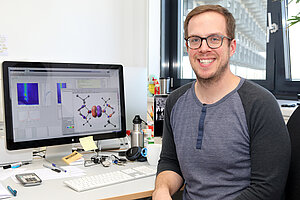Oxygen is an essential molecule for life on earth. Many organisms rely on proteins that contain metals such as iron, manganese and copper, to perform life-critical chemical reactions with O2. For instance, almost all mammals utilize the iron-containing hemoglobin protein to transport O2 throughout their bodies. Other animals, such as horseshoe crabs and giant octopi, use a different protein to transport oxygen, hemocyanin. This copper containing protein is in their blood and binds O2 to form a rich blue color instead of the red color of human blood.
To understand how some other proteins like hemocyanin can bind O2 and then break its strong O-O bond, researchers from Serena DeBeer's group at MPI CEC and the <link https: chem.umn.edu _blank external-link-new-window internal link in current>University of Minnesota have employed an advanced X-ray spectroscopy technique to study this process in model complexes that mimic different possible copper-oxygen motifs. The Valence-to-Core X-ray Emission Spectroscopy (VtC XES) technique is a metal selective probe, that allows the researchers to only look at copper centers and study their ligands.
“These measurements require an incredibly intense synchrotron X-ray source and a large precision built X-ray emission spectrometer, a combination we utilized at beam line ID-26 at the <link https: www.esrf.eu _blank external-link-new-window internal link in current>European Synchrotron Radiation Facility in Grenoble, France. This spectroscopic approach is very sensitive to the ligand environment and we show that it is able to detect whether the bond of O2 is still there or broken,” explains George E. Cutsail III, Postdoc at MPI CEC in the <link internal-link internal link in current>Inorganic Spectroscopy group.
As copper proteins can break and reform the bond O2 quite easily, studying and understanding the two limits is necessary. This study will refine the bonding picture that chemists imagine for copper and oxygen interactions and will serve as a foundation for future studies. Now that there is a new spectroscopic tool to study O2 bonding to copper, one may think about more complicated experiments, including mechanisms of O-O bond breakage and other chemical reactions.
The understanding of activating and bonding of O2 is fundamental and can be applied to many other chemical reactions. “Once we fully understand these complicated processes, we can build better complexes that could support the refinement of industrial processes”, says George.
The findings were recently published and highlighted in the journal Angewandte Chemie International Edition. The publication by DeBeer and coworkers is a joint effort with the group of William Tolman, who is a longtime collaborator of the researchers at the institute and was also awarded the <link internal-link internal link in current>Frontiers Award in 2016.
<link https: www.chemistryviews.org details ezine _blank external-link-new-window internal link in current>Chemistry Views also highlighted this article recently.
Publication: Cutsail III, G.E., Gagnon, N.L., Spaeth, A.D., Tolman, W.B., <link internal-link internal link in current>DeBeer, S.* (2019). <link https: onlinelibrary.wiley.com doi abs anie.201903749 _blank external-link-new-window internal link in current>Valence-to-Core X-ray Emission Spectroscopy as a Probe of O-O Bond Activation in Cu2O2 Complexes. Angew. Chem. Int. Ed. <link https: onlinelibrary.wiley.com doi epdf anie.201903749 _blank external-link-new-window internal link in current>10.1002/anie.201903749

